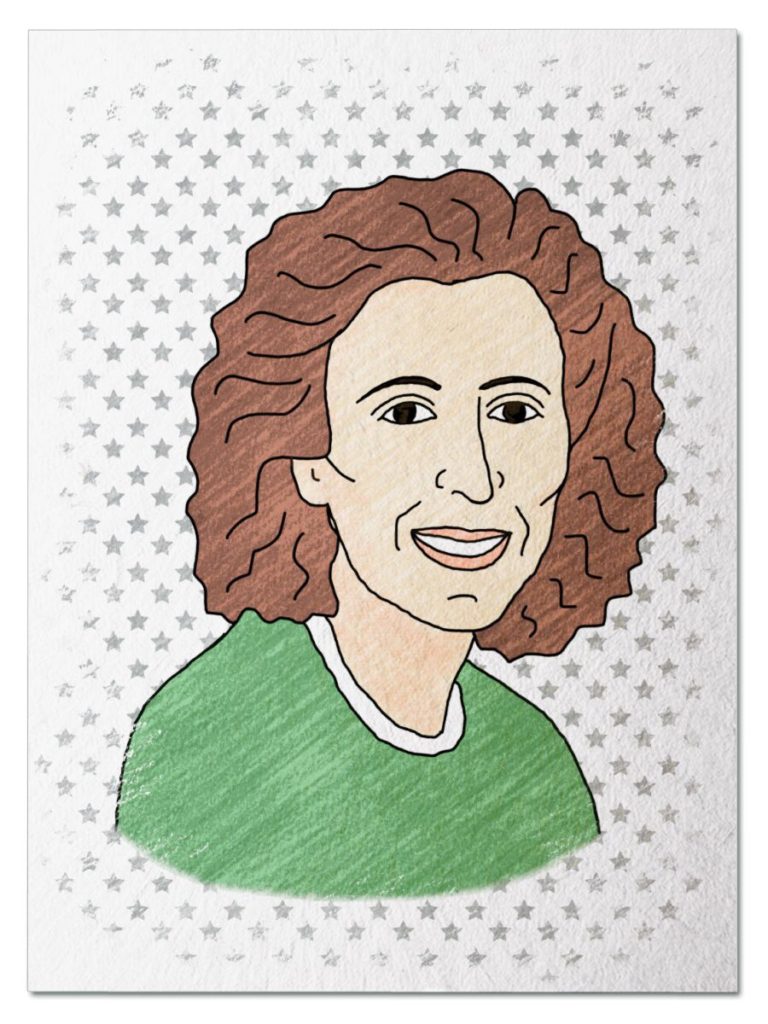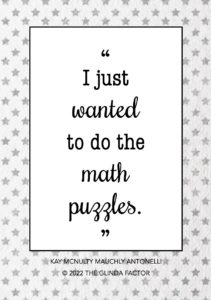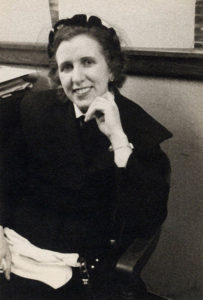
Inspiring Inventor
She was born in Ireland and immigrated to America when she was 3 years old. Her parents insisted that she take advantage of all the educational opportunities in America. Her talent in math became obvious at an early age. She took every math class she could, which earned her a scholarship to college, as well as a job opportunity with the US Army during World War 2. She went on to become one of the first computer programmers in America. Jump back to 1942 and meet Kathleen “Kay” McNulty Mauchly Antonelli …
Her Ruby Shoe Moment
The Power of the Wand
Her Yellow Brick Road
Brains, Heart & Courage
Glinda’s Gallery
Just the Facts
Her Ruby Shoe Moment
On July 1, 1942, Kathleen “Kay” McNulty Mauchly Antonelli reported to the Moore School of Engineering at the University of Pennsylvania. She was led into a room with a few other women and finally told why she was hired — her job was to calculate bullet and missile trajectories for the US Army. It was the middle of World War II and the armed forces needed all the help it could get.
The Army required an artillery firing table for every single weapon used by its troops. Each artillery firing table consisted of about 1800 ballistic trajectories. There was an individual trajectory for every different angle and setting for the gun, as well as weather conditions such as wind, air temperature, and humidity. Soldiers consulted the firing tables before aiming their gun at any distant target.

Kay and her colleagues operated the Differential Analyzer (University of Pennsylvania)
After describing the women’s duties, the director went on to share that no one was available to teach them how to make the calculations. They had to figure it out based on a book and some large spreadsheets that contained previously completed calculations. Fortunately, this was the type of math puzzle that Kay loved to solve. She reverse engineered the whole process, then shared what she learned with everyone else.
The women had to calculate an artillery firing table for each new weapon before it could be used by the troops. And it took them about 40 hours to do the math for each trajectory calculation, with nothing but a mechanical desk calculator. It was a laborious process — about 70,000 hours to complete the artillery firing table for just one gun. Kay and her colleagues worked long hours. They felt the urgency to get the work done quickly and accurately, to help the troops in the field.
 Before long, the Army looked for ways to speed up the process. As talented as the women were, the manual calculations were too time intensive. Luckily for them, there was a machine in the basement of the Moore School, called a Differential Analyzer, that could do the calculations electronically. They just needed to learn how to operate it.
Before long, the Army looked for ways to speed up the process. As talented as the women were, the manual calculations were too time intensive. Luckily for them, there was a machine in the basement of the Moore School, called a Differential Analyzer, that could do the calculations electronically. They just needed to learn how to operate it.
The Differential Analyzer did the work a lot more quickly — it took only 45 minutes to complete the calculations for one trajectory. It took the women 3 days, however, to calculate the information needed to program the machine for each trajectory. Before long, the Differential Analyzer ran 16 hours per day, 6 days per week until the end of World War II.
The Differential Analyzer was a temperamental machine. It had to be kept at a consistent temperature, since the expansion and contraction of its metal parts would throw off all the settings. In addition, the machine became less accurate with prolonged use — the gears and settings tended to “drift” the longer it operated. So Kay and the other women had to constantly troubleshoot, as well as calculate at least one trajectory for each new gun to test the accuracy of the machine’s results.

Kay McNulty Mauchly Antonelli
Kay’s talent at math was obvious to everyone around her. As a result, in 1944 she was chosen for a top secret mission — Project X. A new calculator called the Electronic Numeric Integrator and Computer (ENIAC) was being built at the Moore School, and would be one of America’s first computers.
Kay and 5 other women formed a team of programmers for ENIAC. The work was so top secret, however, that they weren’t allowed in the same room as ENIAC. They had to learn how to operate the machine by inspecting the blueprints, memorizing the switches, wires and vacuum tubes. In addition, they did all their programming on paper, for input into the computer later. To program ENINAC, the women broke down long and complicated equations into the smallest possible steps for the machine to complete. Then, they ensured that ENIAC performed the operations in the correct order.
On February 15, 1946, ENIAC was unveiled to a group of scientists, Army personnel, and university employees. They were given a demonstration of ENIAC’s capabilities, which was the the trajectory program created by Kay and the team of women. They weren’t given recognition for their role until many years later, however.
The Power of the Wand
Kay McNulty Mauchly Antonelli was one of the first computer programmers in American history. Today, women comprise almost 30% of the workforce in science, technology, engineering and math (STEM). Many organizations throughout the nation are trying to close the gender gap — the website, Girls Who STEM, has compiled a list of 40 organizations that encourage girls and women to become involved in STEM.
Her Yellow Brick Road
Kay attended John W Hallahan Catholic Girls’ High School in downtown Philadelphia. And it took her more than an hour to get to and from school every day — with a combination of bus, subway, and walking. Kay took college preparatory classes and excelled at math in particular. She also studied Latin and French, was on the honor roll, and worked on the school newspaper.
After graduation, Kay received a scholarship to attend Chestnut Hill College for Women. It was located in Philadelphia, so she continued to live at home during college. Kay decided to major in math, which came easy to her. She viewed math problems as puzzles to solve and fell in love with the consistency of numbers. So she decided to major in math and took every math class offered at Chestnut Hill College for Women — spherical geometry, differential calculus, projective geometry, partial differential equations, and statistics.

Kay McNulty at high school graduation
At the time, most women who majored in math went into teaching. Kay originally wanted to minor in physics, but worried that the only job it would allow her to do was to teach. But she wanted more options. So Kay decided to minor in business administration instead, in the hopes that it would help her find a job. Kay also worked as a bookkeeper for one summer during college.
There were 90 women in Kay’s graduating class, and only 3 of them received a degree in math. She graduated in 1942, right in the middle of World War 2. Both of her brothers had enlisted in the armed services after Pearl Harbor. All of America was focused on helping the war effort, including academic research. And Kay wanted to be part of it.
Luckily for her, the government was looking for women mathematicians. A few weeks after graduation, Kay saw a recruitment advertisement in The Philadelphia Inquirer newspaper — “Looking for women math majors.” The ad was taken out by the US Civil Service and announced the time and place when interviews would take place. During her interview, the recruiter asked her to list the math classes she took in college. When she answered, he offered her a job on the spot.
Brains, Heart & Courage
Kathleen “Kay” Rita McNulty was born in Donegal County, Ireland. Her family lived on the farm that had been in her father’s family for over 100 years. Kay was born during the Irish War for Independence and her father was a member of the IRA. He had a secret stash of weapons under the floorboards of their house, and was suspected of being involved in the bombing of a bridge. As a result, he was arrested one the night she was born and held in jail for about 18 months without being charged with a crime.
After Kay’s father was released, he decided he couldn’t live under Ireland’s government (the Irish Free State). So he decided to return to America. It was his second time making the journey — he originally immigrated to America in 1909 with his older brother and was apprenticed as a stonemason. In 1923, he re-joined his brother in Philadelphia. Over the years, he worked as a stonemason on the Pentagon, the Treasury Building, and the Jefferson Memorial. It took about one year for him to save enough money for his family to make the passage from Ireland. While he waited for them to arrive, he built a house in Chestnut Hill for them all to live in together.
 Kay and her mother and siblings arrived in October, 1924, when Kay was 3 years old. None of them knew how to speak English when they arrived. In fact, her family spoke only Gaelic at home for many years. It was a multi-generational household — siblings and uncles on both sides lived with them as well.
Kay and her mother and siblings arrived in October, 1924, when Kay was 3 years old. None of them knew how to speak English when they arrived. In fact, her family spoke only Gaelic at home for many years. It was a multi-generational household — siblings and uncles on both sides lived with them as well.
Kay’s parents were very proud of their Irish heritage. Her father was a champion Irish step dancer. And her mother was an accomplished seamstress, as well as Irish embroidery. They had high expectations for their children and wanted to prove that Irish immigrants were just as good as anyone else in America.
Back then, very few girls in Ireland were educated past the age of 14. Only a handful of girls had the opportunity to receive a high school education, and attending college wasn’t an option. So Kay’s parents wanted all their children (boys and girls) to take advantage of the educational opportunities in America.
Kay’s brothers enrolled in school shortly after they arrived from Ireland. And Kay looked at their textbooks every day after school. She taught herself how to read and speak English, and figured out the basics of math. As a result, she was far ahead of her classmates when she started school at age 6. So she skipped the 4th grade. Kay loved school and continued to help her brothers with their homework throughout their years of school.
Glinda’s Gallery
Just the Facts
- Kay was born on February 12, 1921 in Ireland. She immigrated to America with her family when she was 3 years old.
- In 1948, Kay resigned to marry her colleague, John Mauchly. He was a co-inventor of the ENIAC machine. Kay’s parents opposed the marriage and didn’t attend the wedding. They had 5 children (they also raised 2 children from John’s previous marriage). Kay helped John program computers for most of his career (without any recognition). She specialized in software, while John specialized in hardware.
- After John died in 1980, Kay married Severo Antonelli a few years later.
- In 1986, the Letterkenny Institute of Technology established an award and scholarship program in Kay’s name, which has been awarded annually to outstanding computer science students ever since.
- In 1997, Kay was admitted into the Women in Technology Hall of Fame. In addition, Kay received an honorary doctorate from Chestnut Hill College.
- Kay died of cancer in 2006.
- In 2010, a documentary was made about the work of Kay and her colleagues as pioneers in computer programming.
Want to Know More?
Kay McNulty Mauchly Antonelli oral history (https://sites.google.com/a/opgate.com/eniac/Home/kay-mcnulty-mauchly-antonelli)
The Irish Emigration Museum (https://blog.epicchq.com/herstory-irelands-epic-women-kay-mcnulty)
Moye, William. ENIAC: The Army-Sponsored Revolution. January 1996 (https://ftp.arl.army.mil/~mike/comphist/96summary/)
